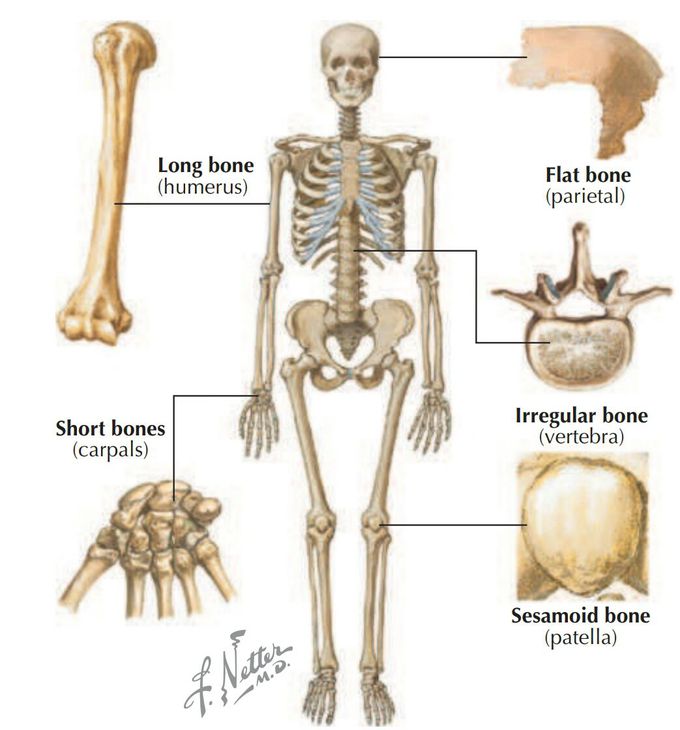


#SKELETAL_SYSTEM ▪Descriptive Regions The human skeleton is divided into two descriptive regions: • Axial skeleton: includes the bones of the skull, vertebral column (spine), ribs, and sternum, which form the “axis” or central line of the body (80 bones). • Appendicular skeleton: includes the bones of the limbs, including the pectoral and pelvic girdles, which attach the limbs to the body’s axis (134 bones). ▪Shapes and Function of Bones The skeleton is composed of a living, dynamic, rigid connective tissue that forms the bones and cartilages. Generally, humans have about 214 bones, although this number varies, particularly in the number of small sesamoid bones that may be present. (Many resources claim we have only 206 bones, but they have ignored the 8 sesamoid bones of the hands and feet.) Cartilage is attached to some bones, especially where flexibility is important, or covers the surfaces of bones at points of articulation. About 99% of the body’s calcium is stored in bone, and many bones possess a central cavity that contains bone marrow—a collection of hemopoietic (blood-forming) cells. Most of the bones can be classiied into one of the following ive shapes: • Long. • Short. • Flat. • Irregular. • Sesamoid. ▪The functions of the skeletal system include: • Support. • Protection of vital organs. • A mechanism, along with muscles, for movement. • Storage of calcium and other salts, growth factors, and cytokines. • A source of blood cells. ▪There are two types of bone: 1) Compact: is a relatively solid mass of bone, commonly seen as a supericial layer of bone, that provides strength. 2)Spongy (trabecular or cancellous): is a less dense trabeculated network of bone spicules making up the substance of most bones and surrounding an inner marrow cavity. ▪Long bones also are divided into the following descriptive regions: • Epiphysis: the ends of long bones, which develop from secondary ossiication centers. • Epiphysial plate: the site of growth in length; it contains cartilage in actively growing bones. • Metaphysis: the site where the bone’s shaft joins the epiphysis and epiphysial plate. • Diaphysis: the shaft of a long bone, which represents the primary ossiication center and the site where growth in width occurs. ▪As a living, dynamic tissue, bone receives a rich blood supply from: • Nutrient arteries: usually one or several larger arteries that pass through the diaphysis and supply the compact and spongy bone, as well as the bone marrow. • Metaphysial and epiphysial arteries: usually arise from articular branches supplying the joint. • Periosteal arteries: numerous small arteries from adjacent vessels that supply the compact bone.
living with Interstitial Lung Disease (ILD) was a daily struggle. I constantly felt out of breath, even while resting. Simple activities like walking to the mailbox or climbing a few stairs left me drained and gasping for air. The medications I was on gave temporary relief, but the side effects made it even harder to cope.In a moment of hope and honestly, exhaustion I decided to try the herbal program from NaturePath Herbal Clinic. At first, I wasn’t sure what to expect. But after a few months on the treatment, I began to notice steady improvements. My breathing became less laboured, my coughing reduced, and I felt more energetic throughout the day.What makes this program different is that it’s completely natural and gentle on the body, unlike many pharmaceutical treatments I had tried in the past. I didn’t experience any negative side effects, and the improvement in my quality of life has been incredible.I’ve now been on the program for over nine months, and my most recent checkup showed that my condition has sthbilized. For a disease that doctors told me had no cure, this was more than I could have hoped for. I feel like I’ve been given a second chance at life.If you or a loved one is battling ILD and struggling to find relief, I highly encourage you to explore this option. It has truly made a difference in my life.their website is www.naturepathherbalclinic.com



